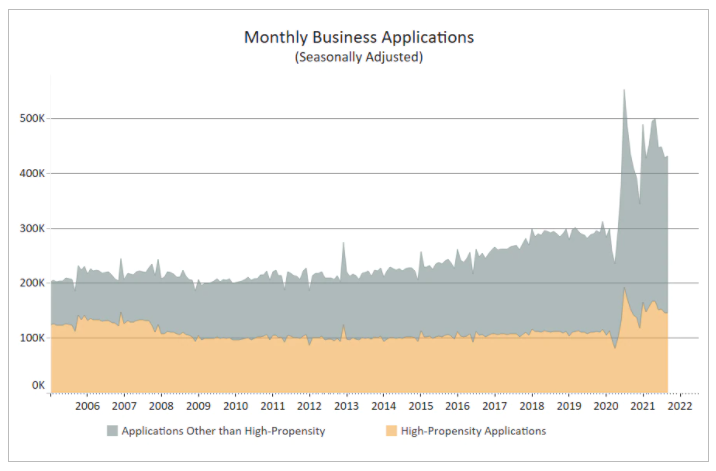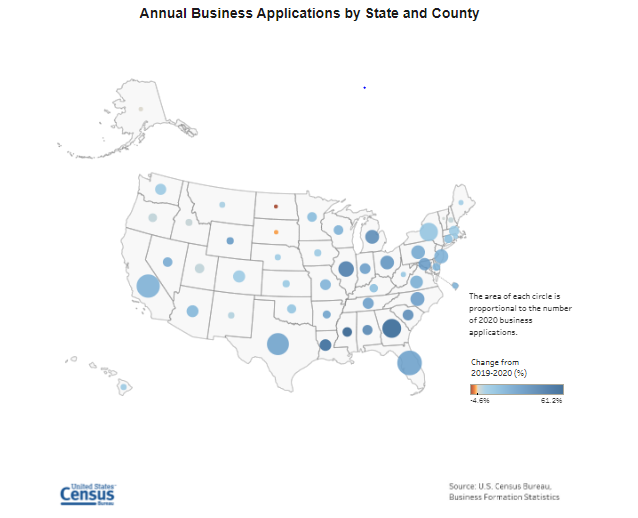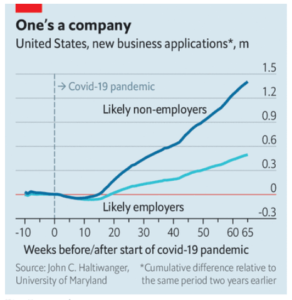As the coronavirus spread, the normal economic figures predicted doom. From February to May 2020, 20 million jobs were eliminated, and the pandemic is negatively impacted the whole global economy. But when it comes to new business formation in US, it is up.
Despite a health crisis and one of the most severe economic downturns in modern history, US start-up activity surged last year—enterprise start-ups climbed by 24%, from 3.5 million in 2019 to 4.4 million in 2020. Economic crises are times of “creative destruction” when new ideas and methods of doing business emerge.
Even the new enterprises that are sprouting up are not simple to generalize about. The change to new technology-based methods of doing the same business was evident in some of them. Investing in digital applications has given companies a new life. Using remote databases and social media to connect with consumers has become second nature for employees. Before the epidemic, the workplace was becoming more and more virtual, and this trend may continue after COVID-19.
Small Enterprises in the United States

A common belief is that small enterprises in the United States generate the greatest employment opportunities. COVID-19’s economic recovery initiatives have so far mostly aided companies and saved employment. Governments have supplied less aid to start-ups. Several countries have set up initiatives to help start-ups during the epidemic. The US program is substantially bigger than other industrialized countries for that. Paycheck Protection Program (PPP) loans are available to small enterprises, including qualified start-ups. Certain requirements must be completed to discharge debts. PPP loans under $50,000 were allowed in August 2020. So, there is an increasing trend of start-up businesses in the USA. The following chart shows that.

Source: US Census Bureau Data
California and Colorado score well.

Entrepreneurship is more likely to thrive in some regions of the nation because they have more favorable business conditions or greater access to resources. West Coast states make up four of WalletHub’s top 10 states for new company ventures or new business formation; the Southeast and the rest of the nation have a solid showing, as well.
Rankings from WalletHub and US News & World Report are similar in many cases; states like California and Colorado score well on both lists, as do Georgia and Idaho, as well as Massachusetts and Utah. Following California, Massachusetts, and New York were the three states with the best access to resources, with the latter two rankings particularly well in terms of human capital availability. In contrast, Oklahoma, Mississippi, and West Virginia scored near the bottom of the list for business expenses.

Source: US Census Bureau Data
Among the many intriguing aspects of the boom was how it occurred amid a particularly difficult era for small firms, the failures of which were documented in an alternate data series that ran until the third quarter of 2020. However, the death and birth of businesses may provide insight into how America’s economy is changing. According to the application forms, eleven different types of businesses accounted for 75% of the total. Retail, and particularly e-commerce, was by far the biggest sector, accounting for about one-third of the total. The Biden administration may be preparing antitrust authorities for an attack on the industry’s behemoths. However, newcomers seem to find potential.
Single-person businesses have grown fourfold since the epidemic started compared to a comparable length of time before the financial crisis. These business-formation figures do not include obvious reasons, such as an increase in the number of persons driving for Uber. This might be due to families relocating, or it could be an indication that new types of remote employment are becoming more common.

Source: The Economist
Other popular areas include food preparation and accommodation, which were also hard-hit last year; trucking (all those goods to deliver); health care; and scientific and technical services—an undefined category that may provide a haven for competent employees fleeing large corporations. Geographically, Texas and Florida performed exceptionally well in terms of new company formation; in percentage terms, the southern arc of Georgia, South Carolina, and North Carolina performed even better.
The US financial system remained solid

Despite the destruction of the last year, the country’s financial system remained solid, as shown by the strong figures. There were no significant drops in housing values or family earnings, which provided a platform for starting a new business. There are, of course, uncertainties regarding whether or not the trend will continue and how significant it is. An employer-identification number EIN is nothing more than a piece of paper, after all.
Rising salaries and strong demand for labor, as well as government benefits for remaining at home, are some of the obstacles that prevent people from working. It is possible that tax and regulatory policies may grow more invasive, expensive, and hostile in the future. According to historical precedent, if these obstacles can be avoided, new businesses often generate a significant amount of employment and productivity growth within a year or two of being formed.




